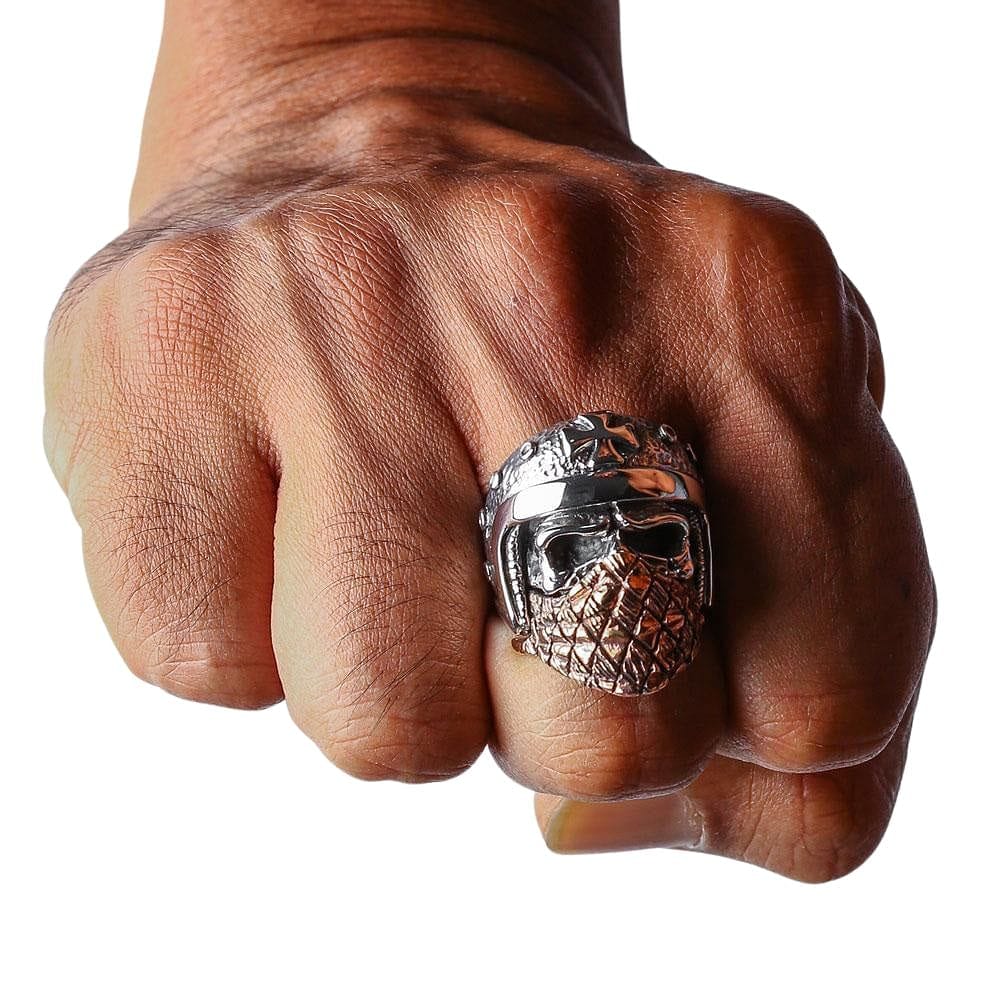This year marks the 20th anniversary of the skull's fashion revolution. In 2003, Alexander McQueen introduced skulls into his collection for the first time, and since then, this symbol has become an iconic trend among mainstream fashionistas. To commemorate its first jubilee, the fashion house has teamed up with Damien Hirst, one of the most influential contemporary artists known for his affinity for skulls. While the brand hasn't prepared anything special for its second jubilee, its website still offers a plethora of skull-adorned bags and scarves. But who says we can't celebrate it ourselves? We’re going to take a journey back in time and explore how skulls have made their way from a graveyard to catwalks around the world.
The Religious and Cultural Heritage of the Skull Symbol
Throughout the ages, humanity has been captivated by the allure of death. In the early stages of societal development, the skull symbolized the recognition of our own mortality and served as a poignant reminder to honor those who have passed away. Cultures across the globe found various uses for different parts of the human body, ranging from venerating ancestors to crafting ritual instruments dedicated to deities. Among all these body parts, the head held a position of utmost importance. Archaeologists have unearthed intriguing clues of ancient rituals, such as ocher-painted skull remains in Neolithic settlements, offering glimpses into the practices of bygone civilizations.
The Celtic tribes also used skulls in their sacred traditions. These formidable warriors preserved the heads of noble adversaries, crafting them into resplendent golden chalices. They believed that the skull served as a vessel for the defeated enemy's spirit, transferring its strength to the victorious warrior when drinking from these cups.
In India, human skulls have long been utilized for religious purposes, particularly in connection with the deities Shiva and Kali. Devotees of Shiva use kapalas, bowls made from the upper part of the skull, in tantric rituals, emphasizing the deity's destructive aspects. On the other hand, Aghoris, a sect of ascetics, engage in meditative practices at cremation grounds, performing various rituals with human remains.
Now let us journey to Mexico, where skulls hold great significance in the vibrant celebrations of the Day of the Dead. This colorful festival intertwines ancestral reverence with Catholic beliefs. The event is brimming with an array of products adorned with funeral symbolism, including the iconic sugar skulls. While death symbols may sometimes be commodified for tourists, Mexicans maintain genuine rituals of communion with the deceased. One such practice is the rite of cleaning, involving the washing of the bones of departed loved ones.

From Religion to Secular Art
Skulls have long held a sacred place in various corners of the world, and it was only a matter of time before they caught the attention of major religions. And indeed, they did.
In Christian tradition, one of the most renowned skulls belongs to none other than the first man, Adam. According to biblical history, after Adam's passing, his remains returned to the earth and found their resting place beneath Golgotha. It is said that the blood of the crucified Savior seeped into the depths of the mountain, cleansing Adam of his original sin and bestowing upon him eternal life. Consequently, it is not uncommon to witness the depiction of Adam's skull at the foot of the cross in crucifixion-themed artwork and religious artifacts.
During the late Middle Ages and Renaissance, death became a central theme in fine art and its macabre narratives. One of the most renowned examples of this is the haunting "Dance of Death," a procession of skeletons playing musical instruments and engaging in a dance with "the great equalizer." This motif found its way into poetry, paintings, frescoes, tapestries, and even carnival processions. These eerie narratives served as moral reminders, urging individuals to live righteous lives as death spares no one. Echoing the theme of memento mori, applied art suggested mourning jewelry. Gold and silver earrings, pendants, rings, lockets, and other accessories were the staples of the era. Visit bikerringshop.com to find more.
The Baroque period witnessed the rise of a captivating pictorial genre known as vanitas, a Latin term meaning "vanity." Skulls emerged as prominent elements in these still-life paintings, accompanied by withering flowers, decaying fruits, hourglasses, and other symbols of life's transient nature. These artworks also depicted earthly treasures scattered in chaotic disarray, highlighting the futility of clinging to material possessions that cannot be taken into the afterlife.
However, skulls did not solely exist within the realm of artistic expression. Throughout the 18th and 19th centuries, secret societies and occult groups continued to incorporate them into their rites and practices. For instance, the skull became a prominent symbol within Freemasonry, while student fraternities utilized human skulls in their initiatory rituals. Legends persist about societies like Skull and Bones at Yale University, suggesting that they still incorporate human remains in their secretive initiation ceremonies.
Military Symbolism: Pirates and Daredevils
While the skull has intricately woven itself into the religious and cultural fabric of nations around the globe, it previously held roles as a ceremonial object, an accessory, or an element of fine art. However, it was only a step away from becoming a part of the fashion world. Surprisingly, it was pirates and soldiers who opened that door and propelled the skull into the realm of style and symbolism.
Within the military and outlaw communities, the skull possessed a dual significance. It struck fear into the hearts of adversaries, yet simultaneously embodied fearlessness and the willingness to make the ultimate sacrifice on the battlefield. Both ruthless warriors and audacious daredevils proudly donned this emblem.
The infamous Jolly Roger flag, once a terror-inducing sight for sailors, lacked a universal design among pirates. It would have been inconceivable to expect a diverse group of sea wolves to adopt a unified symbol. Variations of the Jolly Roger abounded: skulls in profile or full-face, accompanied by hourglasses, crossed sabers, or something else. For instance, Edward "Blackbeard" Teach's flag featured a skeleton aiming a spear at a human heart, poised alongside an hourglass. Yet, the most "classic" pirate flag to this day belongs to Edward England, who wreaked havoc in the Indian Ocean during the 18th century.

Around that same era, skulls started adorning the uniforms of ground troops. Prussian hussars serving under King Frederick the Great proudly displayed this image, as did the 17th Lancers of the British Army and the Brunswick hussars, a volunteer corps under the Duke of Brunswick. It should come as no surprise that the skull found its way onto military banners and uniforms, as soldiers consistently confront the specter of death. For them, the skull and other death-related motifs represented symbols of salvation that could only be attained through the pursuit of higher goals or self-sacrifice.
During World War I, the skull symbol emerged on both sides of the conflict. Russian aviators had it as an award badge and shock troops of the Russian Army carried it as their emblem. Meanwhile, German tanks bore the skull insignia as well. In World War II, divisions of the German Wehrmacht and SS displayed skull imagery on their hats and rings. Simultaneously, American pilots adorned their aircraft with Jolly Roger flags and winged skulls, further emphasizing their connection to the world of pirates and daredevils.
From Subcultures to (Necro)glamour
During the latter half of the 20th century, the skull emerged as a shocking emblem within diverse subcultures. It all began with bikers, the trailblazers of this phenomenon and veterans of World War II. They seized the insignia of their vanquished foes as trophies and brought them home. However, they soon discovered that the freedom they had experienced on the battlefield did not extend to their everyday lives. Society's norms, laws, and moral codes bound them. In an act of defiance, they started forming motorcycle clubs, and the skull insignia gradually infiltrated their regalia. Notably, the renowned Hell's Angels, founded by pilots from the eponymous division (which featured a winged skull on its banners), played a pivotal role in popularizing the symbol.

A couple of decades later, in the rebellious 1970s, the skull caught the attention of punks. Inspired by the bikers, they viewed it as a tangible embodiment of rebellion and nonconformity. This captivating motif swiftly spread to other music-related subcultures such as goths, metalheads, rockers, and more. Skulls began adorning leather jackets, denim attire, wallet chains, pendants, rings, tattoos—the list goes on.
However, in the new millennium, the skull's exclusivity began to wane. In 2010, Hell's Angels took Alexander McQueen's fashion house to court for appropriating their iconic symbol—a skull with wings—in their clothing designs. The bikers' legal representative argued that the matter transcended financial compensation: the privilege to wear the symbolism was reserved exclusively for club members. Eventually, the case was settled. However, fashion lost the battle but didn’t lose the war. In a strategic sense, fashion emerged victorious over subcultures.
Today, the skull has transcended its role as a mere symbol of protest and evolved into a glamorous icon. Skulls bedazzled with rhinestones have become coveted accessories among mainstream fashionistas, and some clothing brands even incorporated the skull into their logos.
A quick browse through any retail platform will unveil an abundance of products featuring "dead heads": scarves, bags, accessories, socks, and more. Jewelry brands don’t lag behind, constantly rolling out new exciting collections. Check out some of these products at https://www.bikerringshop.com/collections/skull-pendants. As a decorative element, the skull makes its appearance on a wide range of everyday items, from luxurious bed linen to embellishments on toilet paper.

The glossy portrayal of death-themed images has amusingly been coined "corpse chic." In today's fashion landscape, there are no longer distinct boundaries separating symbols into acceptable and taboo categories. You are free to express yourself and wear whatever captures your imagination, whether it be a daring fashion statement or a profound symbol with personal significance.
Post Comment
Be the first to post comment!






